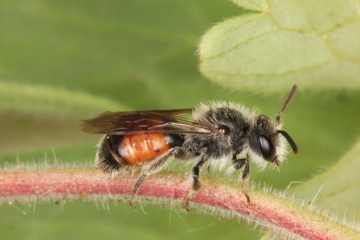Species Account for Andrena labiata
Andrena labiata Fabricius, 1781
Girdled Mining Bee
Aculeata: Andreninae

Reproduction for study and non-profit use permitted, all other rights reserved.
Taxonomic group: bees and wasps (Aculeata) - County data
View time series maps for Andrena labiata
member log-on for taxon report
Status: Na
Essex RDB: Listed
Threat: Essex Threatened
Images
upload a new image
Essex Red Data List comment
forages on Veronica chamaedryas
Species text
This mining bee is recorded widely in England north to Warwickshire but very local. The bee has declined significantly and has apparently disappeared from many former parts of its range. It is generally very scarce in its former strongholds such as Devon, the London district and nearby Surrey Commons. The bee is known from a wide variety of habitats including heathland, grasslands, open woodland, coastal landslips and soft rock cliffs (Falk, 1991b). There is a close and possibly obligate association with germander speedwell, Veronica chamaedrys, which is the main pollen source, but other flowers are recorded, probably mostly as nectar resources. Nest burrows are dug in sandy banks and slopes in sunny situations. Large nesting aggregations appear to be unusual and the normal nesting habits are as isolated individuals or small groups. The species is the host of the RDB1 cleptoparasitic bee Nomada guttulata. References
Habitats
Recorded management for locations with Andrena labiata
Recorded substrate and hydrology for locations with Andrena labiata
Why not join the Club, register and add a new species page
Interpretation of distribution maps




















